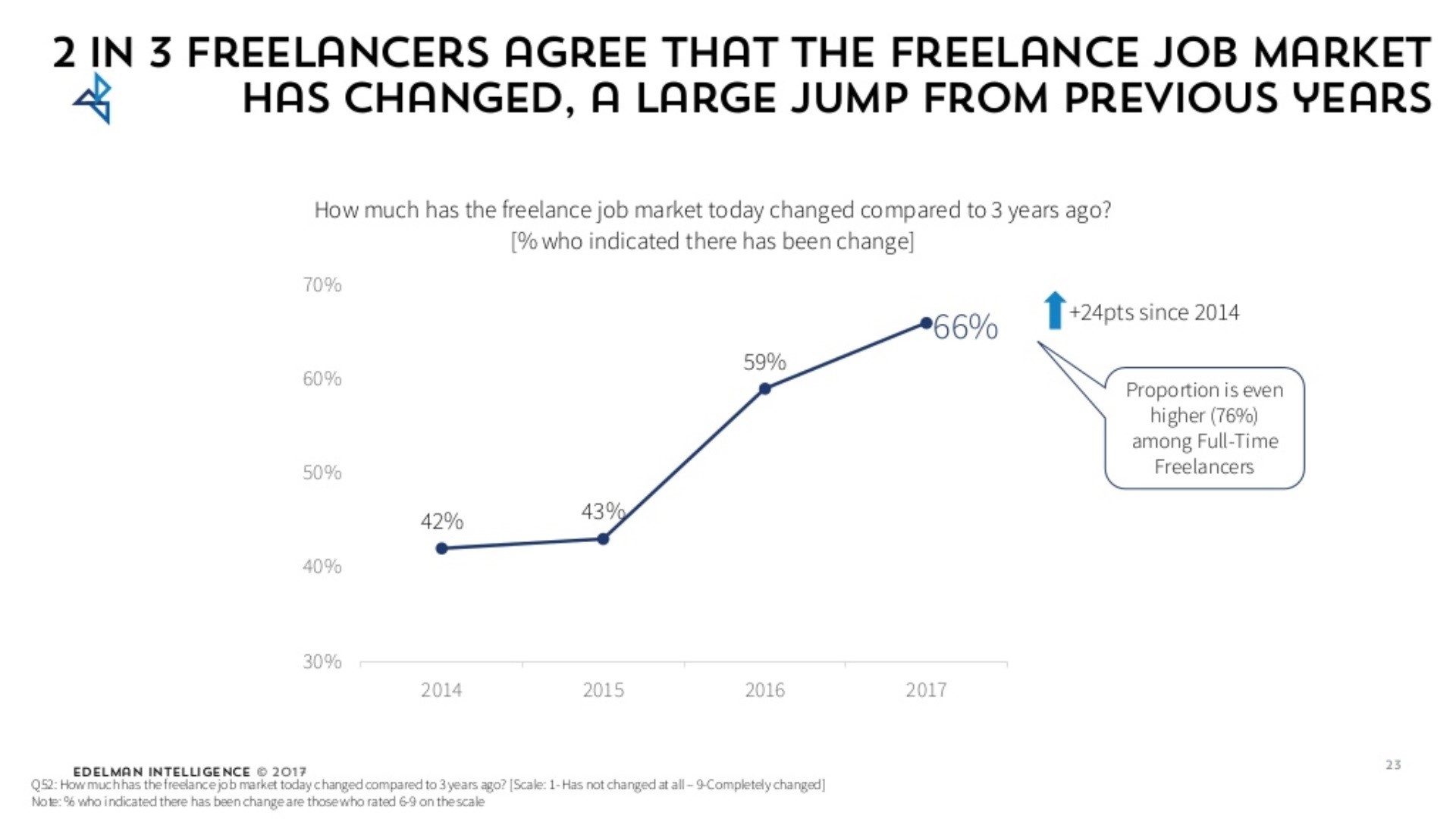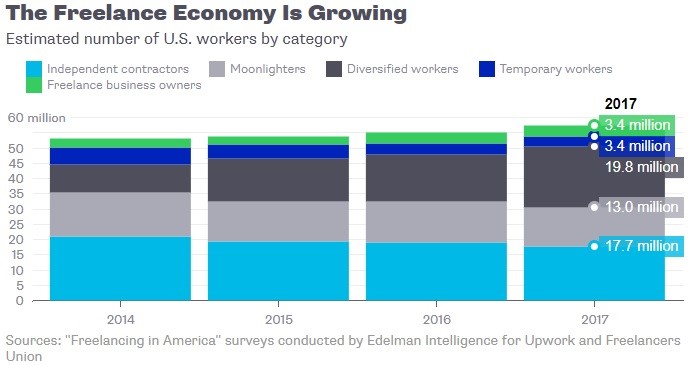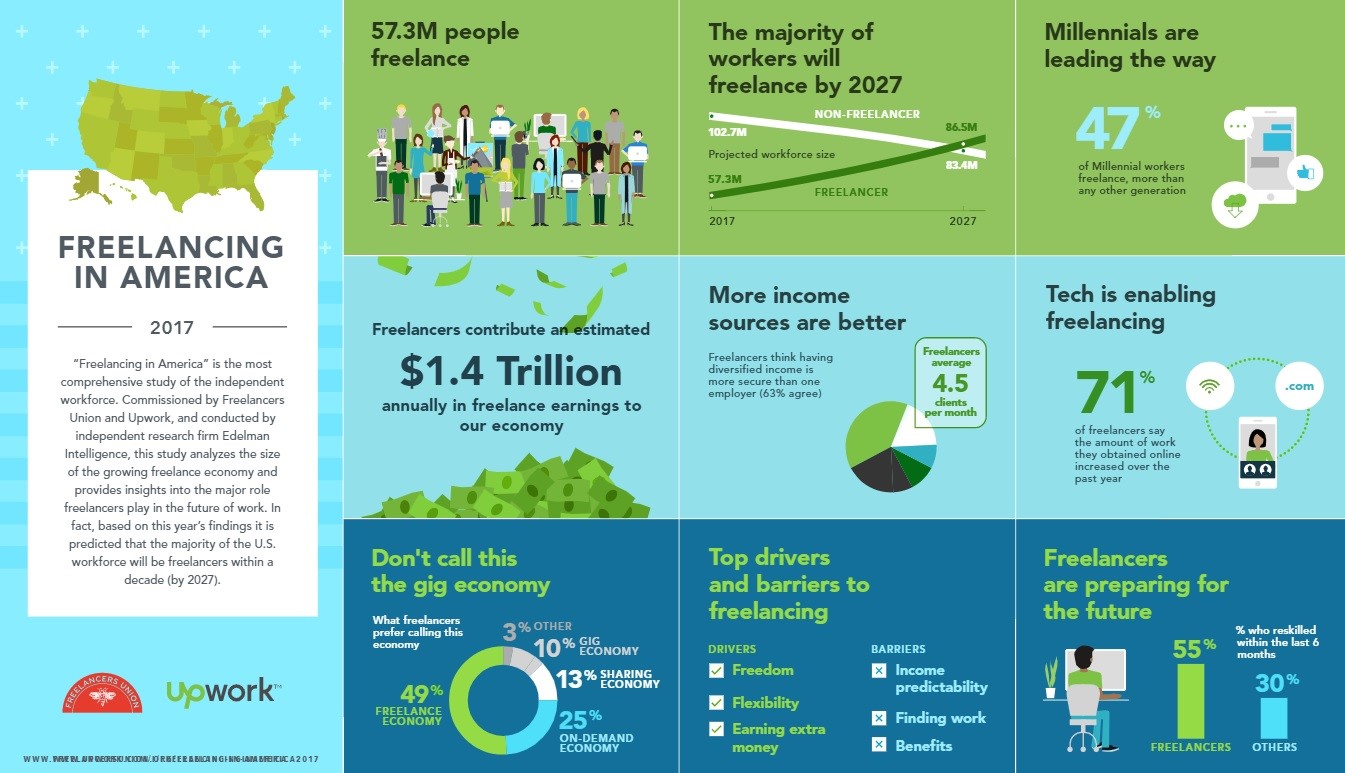UPFINA's Mission: The pursuit of truth in finance and economics to form an unbiased view of current events in order to understand human action, its causes and effects. Read about us and our mission here.
Reading Time: 5 minutes
New Economy- New Labor Market
The labor market is dynamic. The most obvious recent change in the labor market is how millennials are more likely to change jobs than baby boomers. That pays off for them as job switchers have higher wage growth than those who stay at one job as we have detailed previously in our article on financial literacy. That is just the tip of the iceberg. We have a few new trends to discuss in this article. Not only is the economic analysis interesting, but it can also help you with the way you think about your own career. It’s now easier than ever to pick up a part time gig. As long as your company allows you to work for other firms on the side, you can easily work from home to earn extra money on the weekends.
Bureau of Labor Statistics (BLS) Doesn’t Reflect The Changes In The Labor Market
The BLS survey shows that the amount of people who are self-employed or working multiple jobs is declining, but that doesn’t meet the smell test. The ease of working from home by coding or blogging on the side is so much easier now; this makes it clear the number of people doing this has increased. Although the unemployment rate is low, wage growth has been nonexistent, making the economic incentive high to earn extra money. The BLS asks questions based on the old way of thinking. It’s possible to be a freelancer without being self-employed or having multiple jobs, meaning there are workers who are slipping through the cracks of this survey.
Independent & Moonlight Work Is On The Decline
The chart below helps to fill this unknown information. It is a survey done by Edelman Intelligence. It surveys less people than the BLS, but asks more in-depth questions to better characterize the type of work people are doing.
The total number workers in this category is up in the past 4 years. The number of independent contractors and moonlighters fell. A moonlighter is someone with a traditional full-time job who does freelance work on the side. An independent contractor works project to project. This is the old economy way of describing work in the freelance category. This decline is likely why the BLS is showing a decline in those with multiple jobs. The size of the temporary workforce is also declining. That’s because of the tight labor market. There are many firms who are keeping their workers later or hiring workers who are ordinarily temp workers to join the company full-time to fill the void.
Diversified Work Is Driving The Increase In Freelancers
The big increase is coming from the diversified workforce category. This is a mixture of freelance work and traditional part-time work. It’s an ‘all of the above’ strategy to have the ultimate flexibility when it comes to choosing the work these people do on a day-to-day basis. If you work for one company, it’s a big deal to switch jobs. It’s becoming more common to switch jobs, but it’s still not easy. If you work multiple jobs, you can mix and match jobs depending on which offers the best pay and responsibilities. We don’t want to oversell this by claiming it’s for everyone. It depends if you enjoy working in teams for a duration of time, seeing not just projects, but the development of the company which you are fully invested in or if you like being more independent where you jump from protect to project at different firms. Working for one company can be rewarding because you see the ups and downs as a team, while you can be disenfranchised from a firm if you only work for 10 hours per week for example.
Diversified work is more uncertain, but at the same time safer. It’s uncertain because you need to mix and match who to work for. There can be times when you don’t have adequate work. It’s safer because being diversified means you aren’t beholden to one firm for your livelihood. More people are seeing the benefits of freelance work as 63% are doing it by choice opposed to 53% in 2014. In the past 4 years, 12% more people are freelancing full-time, while 6% less are part-time freelancers, and 3% less are full-time employees who earn extra money from freelance work. 59% of freelancers started within the past 3 years showing how this alternative just recently became a viable career option for many workers.
The infographic below makes a few great points about this change in the labor market.
If the growth rate continues, there will be more freelance workers than non-freelance workers in 2027. It’s not a surprise millennials are leading the way as they are tech savvy and these new jobs surround the use of technology. The percentage of those ages 18-34 who work as freelancers is up 9 points in the past 4 years to 47%. It’s also a good way to get into the labor market, if you can’t find a full-time job. If you don’t know what you like, you can dabble in a few types of work and at a few types of firms to help you figure out what you want to do full-time. One of the other points we didn’t mention about how freelancing is safer is that these workers are always advancing their skills as they apply to more gigs than a non-freelance worker. 55% of freelancers have reskilled in the past 6 months, while only 30% of non-freelancers have reskilled in that time frame. Having more skills is a great defense against automation. It’s also worth noting that many of these freelance gigs like coding are less at risk to being replaced by robots. The other negative we didn’t mention is that freelancers don’t get benefits like health insurance and 401(k) matching.
Conclusion
The labor market has changed completely in the past 10 years as technology has reinvented what it means to have a job and how many jobs workers have at once. There’s no reason to utilize the BLS report to measure these changes. That would be like asking a CD manufacturer to track the growth in music streaming. The new stats show how the freelance economy is seeing breakneck growth in the diversified category. To provide support for our claim that the labor market is rapidly changing, the chart below shows a survey which asks how much the freelance job market has changed in the past 3 years. The ranking was on a scale of 1-9 (1= no change, 9= completely changed). Those who picked 6-9 are plotted in the chart. There has been a 24% increase in those who said it changed from previous years between 2014 to 2017.
Have comments? Join the conversation on Twitter.
Disclaimer: The content on this site is for general informational and entertainment purposes only and should not be construed as financial advice. You agree that any decision you make will be based upon an independent investigation by a certified professional. Please read full disclaimer and privacy policy before reading any of our content.













